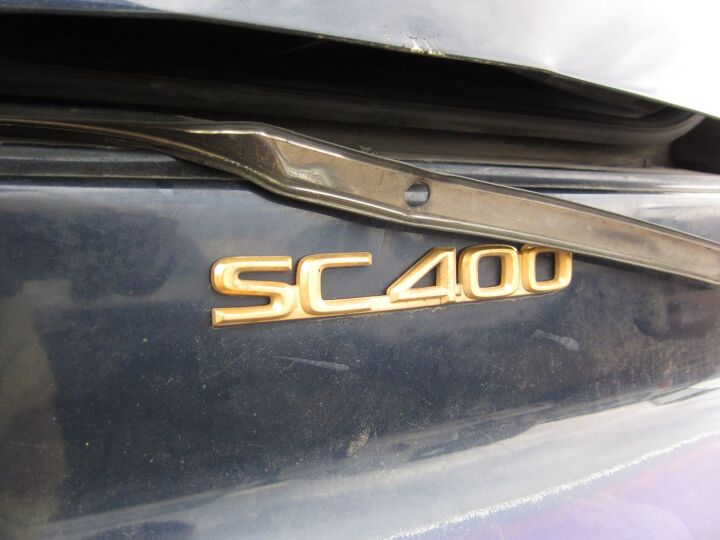Junkyard Find: 1994 Lexus SC400

I’ve been seeking out Japanese luxury Junkyard Finds lately, so this fairly straight example of Toyota’s personal luxury coupe of the 1990s seemed worthy of inclusion in the series.
The early SCs were USDM-ized Toyota Soarers with either the Supra’s 3-liter 2JZ six or the 1UZ V8 from the Celsior/LS400.
My ’97 LS400 has this engine, and it’s smooooooth. It wasn’t incredibly powerful (just 256 horses), however, which was something of a weak point for the sporty-looking SC400.
Just like most other 15-plus-year-old German and Japanese high-end machines, when an SC gets a bit battered or develops some expensive mechanical problem, it just isn’t worth keeping alive. I see a lot more LSs than SCs in the self-service yards these days, but the SCs aren’t particularly rare in this context.

Murilee Martin is the pen name of Phil Greden, a writer who has lived in Minnesota, California, Georgia and (now) Colorado. He has toiled at copywriting, technical writing, junkmail writing, fiction writing and now automotive writing. He has owned many terrible vehicles and some good ones. He spends a great deal of time in self-service junkyards. These days, he writes for publications including Autoweek, Autoblog, Hagerty, The Truth About Cars and Capital One.
More by Murilee Martin
Latest Car Reviews
Read moreLatest Product Reviews
Read moreRecent Comments
- Varezhka Dunno, I have a feeling the automakers will just have the cars do that without asking and collect that money for themselves. Just include a small print in your purchasing contract.I mean, if Elon Musk thinks he can just use all the Teslas out there for his grid computing projects for free, I wouldn't be too surprised if he's already doing this.
- Varezhka Any plans yet for Stellantis to wind down some of their dozen plus brands? I mean, most of their European brands (except Fiat and Maserati) are not only 80~90% European sales but also becoming old GM level badge jobs of each other. Lots of almost identical cars fighting within the same small continent. Shouldn't they at least go the Opel/Vauxhall route of one country, one brand to avoid cannibalization? The American brands, at least, have already consolidated with Dodge/Chrysler/Jeep/RAM essentially operating like a single brand. An Auto Union of a sort.
- Namesakeone I read somewhere that Mazda, before the Volkswagen diesel scandal and despite presumably tearing apart and examining several Golfs and Jettas, couldn't figure out how VW did it and decided then not to offer a diesel. Later, when Dieselgate surfaced, it was hinted that Mazda did discover what Volkswagen was doing and kept quiet about it. Maybe Mazda realizes that they don't have the resources of Toyota and cannot do it as well, so they will concentrate on what they do well. Maybe Mazda will decide that they can do well with the RWD midsized sedan with the inline six they were considering a few years ago
- IH_Fever A little math: An average, not super high end EV (like a model 3) has 70 kwh of storage assuming perfect fully charged conditions. An average 2-3 person home uses roughly 30 kwh per day. So in theory you have a little over 2 days of juice. Real world, less than that. This could be great if your normal outage is short and you're already spending $50k on a car. I'll stick with my $500 generator and $200 in gas that just got me through a week of no power. A/c, fridge, tv, lights, we were living large. :)
- EBFlex No. The major apprehension to buying EVs is already well known. The entire premise of the bird cage liner NYT is ridiculous.The better solution to power your house when the power goes out is a generator. Far more reliable as it uses the endless supply of cheap and clean-burning natural gas.














































Comments
Join the conversation
Oh, I caught the "most" and was worried that mine might be in that category. I do get your point however -- maybe mine isn't problematic. Let's see how's she's running in three or four weekends after I get some new tires on it and take care of the due (but thankfully not overdue!) maintenance items.
Couple of interesting things about this car: It has a hydraulic fan drive. In the US, this car and the Camry V6/ES300 of the early 90s (starting with the 1992 model year) had them -- and did not share any components. The US-market LS400 had a big 2-stage AISIN viscous clutch fan and twin electric pushers, but the JDM Celsior had the same hydraulic fan (and no pushers) that the SC400 got here. The fan pump was just replaced with a bearing mount for the viscous fan on the LS400. The ES300/Camry setup used twin pumps on a common shaft - one for power steering, one for the fan, with a common fluid supply that would suck the fan drive side dry first if there was ever a low-fluid condition, while the V8s used a completely stand-alone system. Toyota had a thing for multiple electronic modules. The SC400 had an engine module, a transmission module, a fan drive module, an instrument panel module, an HVAC module, etc. A US car would roll up all the powertrain functions into one module and use a body electronics module for the "hotel" functions. The hydraulic fan drive inspired the similar system on the later Lincoln LS and Nuevo Baby Bird, using the same AISIN motor as the Camry/ES300 but powered by a modified Ford C-III power steering pump. The aborted CDT139 (Jac Nasser, cancelling the CDT139 just as it was getting entertaining: "We're not doing any more projects with Mazda". 6 months later: Ford buys controlling interest in Mazda at behest of Sumitomo Bank) that would have been the 1998 Cougar was going to have a similar system. Yes, I was involved in that. While I did not write the code, I did write the control logic trees used for it. One bit of weirdness from the Toyota control system that had me perplexed was the inclusion of throttle position in the fan logic. Until we had a tip-in fan flare problem (sitting at light with AC on and fan operating at elevated duty cycle, when the light changes and you accelerated, the fan would speed up and make noise). Then I realized they were looking at TP not as an absolute value but for rate-of-change, and would dump fan duty cycle on tip-in, preventing flare. A quick bit of coding later, and we had it fixed. Yeah, this is TL;DR. But my brain needs a break and this was a good outlet. :)